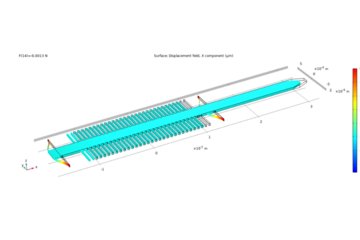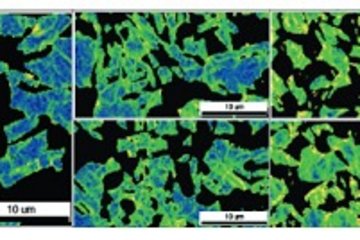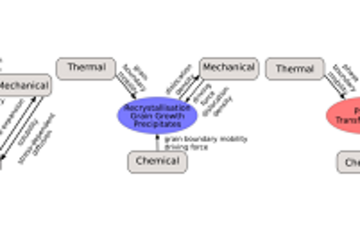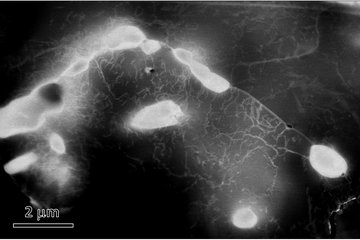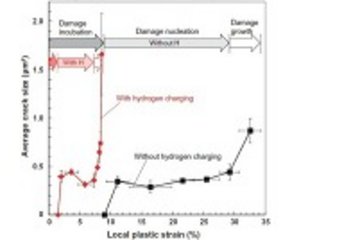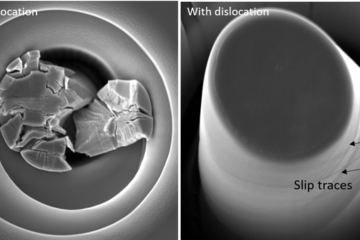All genres
1.
Journal Article
Dynamic strain aging in the intermediate temperature regime of near- titanium alloy, IMI 834: Experimental and modeling. Acta Materialia 222, 17436 (2022)
2.
Journal Article
Chemical heterogeneity enhances hydrogen resistance in high-strength steels. Nature Materials 20, pp. 1629 - 1634 (2021)
3.
Journal Article
Understanding creep of a single-crystalline Co–Al–W–Ta superalloy by studying the deformation mechanism, segregation tendency and stacking fault energy. Acta Materialia 214, 117019 (2021)
4.
Journal Article
Atom probe tomography. Nature reviews: Methods primers 1, 51 (2021)
5.
Journal Article
Precipitation formation on ∑5 and ∑7 grain boundaries in 316L stainless steel and their roles on intergranular corrosion. Acta Materialia 210, 116822 (2021)
6.
Journal Article
The role of Ti addition on the evolution and stability of γ/γ′ microstructure in a Co–30Ni–10Al–5Mo–2Ta alloy. Acta Materialia 208, 116736 (2021)
7.
Journal Article
On the compositional and structural redistribution during partial recrystallisation: a case of σ-phase precipitation in a Mo-doped NiCoCr medium-entropy alloy. Scripta Materialia 194, 113662 (2021)
8.
Journal Article
Effect of interface dislocations on mass flow during high temperature and low stress creep of single crystal Ni-base superalloys. Scripta Materialia 191, pp. 23 - 28 (2021)
9.
Journal Article
Elemental Sub-Lattice Occupation and Microstructural Evolution in γ/γ′ Co–12Ti–4Mo–Cr Alloys. Microscopy and Microanalysis; First View, pp. 1 - 5 (2021)
10.
Journal Article
Effects of Mo on the mechanical behavior of γ/γʹ-strengthened Co–Ti-based alloys. Acta Materialia 197, pp. 69 - 80 (2020)
11.
Journal Article
Development of new γ′-strengthened Co-based superalloys with low mass density, high solvus temperature and high temperature strength. Materials Science and Engineering A: Structural Materials Properties Microstructure and Processing 790, 139578 (2020)
12.
Journal Article
On the effect of W addition on microstructural evolution and gamma' precipitate coarsening in a Co–30Ni–10Al–5Mo–2Ta–2Ti alloy. Materialia 10, 100632 (2020)
13.
Journal Article
(Al, Zn)3Zr dispersoids assisted η′ precipitation in an Al–Zn–Mg–Cu–Zr alloy. Materialia 10, 100641 (2020)
14.
Journal Article
Publisher Correction: Unveiling the Re effect in Ni-based single crystal superalloys. Nature Communications 11 (1), 1076 (2020)
15.
Journal Article
On the atomic solute diffusional mechanisms during compressive creep deformation of a Co–Al–W–Ta single crystal superalloy. Acta Materialia 184, pp. 86 - 99 (2020)
16.
Journal Article
Unveiling the Re effect in Ni-based single crystal superalloys. Nature Communications 11, 389 (2020)
17.
Journal Article
On the formation of hierarchical microstructure in a Mo-doped NiCoCr medium-entropy alloy with enhanced strength-ductility synergy. Scripta Materialia 175, pp. 1 - 6 (2020)
18.
Journal Article
Design of high-strength and damage-resistant carbide-free fine bainitic steels for railway crossing applications. Materials Science and Engineering A: Structural Materials Properties Microstructure and Processing 759, pp. 210 - 223 (2019)
19.
Journal Article
Insight into the effect of Ti-addition on diffusion-controlled growth and texture of Nb3Sn intermetallic superconductor phase. Materialia 6, 100276 (2019)
20.
Journal Article
In-situ observation of strain partitioning and damage development in continuously cooled carbide-free bainitic steels using micro digital image correlation. Materials Science and Engineering A: Structural Materials Properties Microstructure and Processing 757, pp. 107 - 116 (2019)




